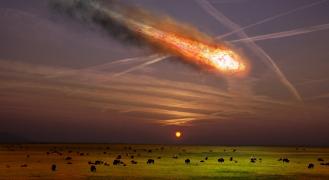Afateful asteroid caused the demise of the (non-avian) dinosaurs 65 million years ago. But that wasn’t an isolated event. Many of the mass extinctions in our planet’s past were caused by meteorite impacts, and it remains a clear and present danger today. In 2013, the Chelyabinsk meteoroid, as big as a six-story building, broke up over Russia and produced a blast stronger than a nuclear explosion. Only a century earlier, the Tunguska meteoroid exploded over Siberia, flattening 80 million trees over an area of 2,150 square kilometers.
The largest impact event in Earth’s history occurred shortly after our planet formed, when it collided with a Mars-sized planetary body. That resulted in the creation of Earth´s Moon and long-lasting magma oceans on the surface, which made our planet uninhabitable for some time.
Cosmic killers
Asteroid impacts can cause a succession of events that extinguish life. In the case of the dinosaur extinction, the initial kill mechanism was the ejection into the atmosphere of particles that block sunlight, preventing photosynthesis and leading to a major die-off of plants. What followed were food shortages and drastic climate swings following the large impact causing the extinction of animals that rely on the plants directly or indirectly for food.
Asteroids are hardly the only danger from space. Supernova explosions have been linked to a minor mass extinction just 2.6 million years ago and to the late Devonian mass extinction about 350 million years ago, which resulted in the loss of three-quarters of all species on our planet. Nearby supernova explosions kill by showering Earth’s atmosphere with radiation that destroys our protective ozone layer. Luckily, the closest star in danger of going supernova any time soon is Betelgeuse, which is 640 light-years away. (The late Devonian supernova was just 65 light-years away.)
An even worse disaster would result if Earth got caught in the narrow “beam” of a gamma-ray burst resulting from the explosion of a massive star or the collision of two neutron stars. Gamma-ray bursts produce almost unimaginable amounts of energy and can kill from much further away. Such a cataclysm has been proposed as the cause of the Ordovician-Silurian mass extinction about 450 million years ago, which killed half of all animal life on Earth.
Wolf-Rayet stars, which are at least 20 times as massive as our Sun, are capable of unleashing gamma-ray bursts. One such star, WR-104 in the Gamma Velorum system, is 800 light-years away. That seems safe enough, but it may not be, as the star’s spin axis is more or less pointed in our direction. A gamma-ray burst could be coming at us with light velocity, and there would be no warning time.
James Webb Space Telescope to the rescue
Now, the good news. The recently launched James Webb Space Telescope (JWST) may help us recognize some of these cosmic threats ahead of time. One of the main goals of JWST is to image planets around other stars, but it also will be able to observe small bodies such as asteroids and comets in our own solar system. Even while it was still in its commissioning period, the telescope tracked an asteroid (Tenzing 6841) — the first time a space observatory has been able to do so.
One of JWST’s early observing programs involves Wolf-Rayet (WR) stars and how they affect dust in the interstellar medium. That may lead to a better understanding of when these objects might produce gamma-ray bursts.
However, even if JWST acts as an alarm system for certain space dangers, some calamities would provide little or no warning. Given that there might be many more “rogue planets” out there than planets bound to stars, one of these may cross our path someday. So could a neutron star or a black hole, which would spell doom for our whole solar system. It wouldn’t even have to hit us directly. By de-stabilizing the orbits in the asteroid belt or the Oort cloud, it would hurl countless numbers of asteroids or comets in our direction.
The ultimate solution to these cosmic threats, if we want to survive into the far future, is to become a multi-planetary species. In the meantime, let’s at least keep watch for any dangers looming out there. We do not want to end up like the dinosaurs.
This article was reprinted with permission of Big Think, where it was originally published.




